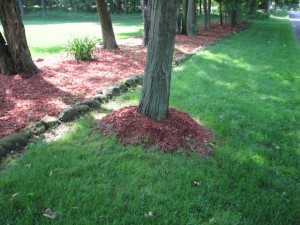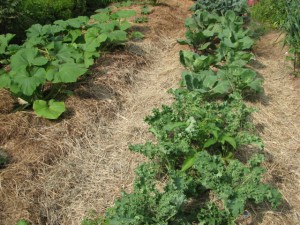To Mulch or Not to Mulch – and How?
For more than a month small trucks laden with chipped bark or wood chips have been scurrying around, unloading piles of mulch. Mulch (from the rich dark color of Mississippi mud to the orange hues of your grandmother’s pumpkin pie) has been spread over flower beds and piled high against the trunk of trees. It will hold down weeds and keep in moisture. But using mulch can have a downside, too. Let me explain.
It is important, if you are using a wood-based mulch, to put on a layer of an appropriate thickness. You shouldn’t just add a new layer of that pumpkin-colored mulch to last year’s mulch just because it’s dirty or the color has started to fade. You need to rake off the old mulch before applying a new layer. A gentle spring rain will not penetrate a 4-6 inch layer of mulch, and eventually the soil will dry out.
Next, there is the question of how mulch is applied near trees. Some landscapers favor the “volcano” look. While it is true that a 12-inch volcano of mulch will keep grass from growing up around your favorite crab apple tree, the mulch will eventually lead to bark rot, a compromised cambium layer, and a slow death. (Except for blueberries, which seem to thrive on mulch or sawdust piled right up to their stems).
Any wood-based, chipped mulch will eventually be host to fungi that break it down. Those same fungi will work on the bark of your tree and eventually break it down, too. Because it takes 6-12 years for a tree to decline and die from compromised bark, the cause and effect is not obvious. You can avoid the problem by leaving a donut hole around the tree – 6 inches of clear space between the trunk and the ring – the donut – of mulch.
Then there is the question of what is in your wood mulch? As a landscaper and garden designer I have occasionally needed to buy a few bags of wood mulch, even though I prefer to buy in bulk from a family-run business that makes its own. But when I do need to buy mulch, I read the label. If the mulch has been dyed with a chemical, I avoid it and go elsewhere to buy good mulch. Why? Because I am an organic gardener. It’s true that most gardeners only use wood-based mulch on flower gardens. Still, I don’t want chemicals introduced to my environment, or that of my clients.
Some years ago I visited radio personality Ray Magliozzi (of NPR’s Car Talk program) at his home in a Boston suburb. Ray was a late-comer to the organic movement. He became an organic gardener after his beloved collie died of cancer. He realized that the lawn jockeys he hired were spreading weed and fungus killers, along with their mowing and fertilizing. He questioned if there was a relationship between his dog’s illness and the chemicals. The same question could be asked about the chemical dye in mulch. What is it? How does it affect us?
So what are the alternatives to commercial wood-based mulch? My choice? Chopped leaves. Leaves run over by the lawnmower and saved last fall for use now. Trees mine minerals from the soil, and then shed their bounty to share with us each fall. Once wet, they don’t tend to blow away.
What about cocoa or buckwheat hulls? They are very tidy to look at and I’ve tried both, but they are very expensive to buy. Cocoa hulls, freshly applied, smell like chocolate chip cookies to me – and some dogs. I have heard that dogs can be sickened (or worse) by ingesting cocoa mulch (chocolate can be poisonous to dogs). That may be part urban myth, of course, but I tend to stay on the safe side. Cocoa hulls also tend to develop a slippery mold layer for a week or so, though it disappears eventually.
I use a layer of 4-6 sheets of newspaper covered with hay or straw in the walkways of my vegetable garden and around large plants, and it is effective at keeping down weeds. The inks are now soy-based and safe to use (in the old days the inks had heavy metals). I soak the papers overnight in a plastic bin first and drain the water in the driveway to get rid of any soluble chemicals in the papers.
Landscape fabric comes in many kinds. The good stuff is tough enough you can’t tear it with your hands; it allows rain to pass through, but little sunshine for hopeful weeds. My feed-n-grain store sells it by the foot, cutting it off a large wide roll, which is handy. It looks best with a thin layer of mulch on top. Black plastic is used by some in the vegetable garden, but it breaks down after a year and needs to go to the landfill. I avoid it.
Nature’s most persistent mulch is, of course, stone. I like small stones for walkways or occasionally in a flower bed. In either case, a layer of landscape fabric will do wonders for inhibiting weed growth.
So take a look around. If you see bark mulch being piled up on a tree trunk, make a citizen’s arrest. Or hand the culprit this article.
Henry Homeyer is a life-long organic gardener, gardening consultant, and UNH Master Gardener. His Web site is www.Gardening-guy.com.




